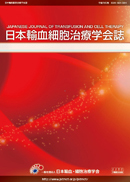Volume 70, Issue 1
Displaying 1-8 of 8 articles from this issue
- |<
- <
- 1
- >
- >|
Review
-
2024Volume 70Issue 1 Pages 1-6
Published: February 26, 2024
Released on J-STAGE: March 15, 2024
Download PDF (282K)
Guideline
-
2024Volume 70Issue 1 Pages 7-11
Published: February 26, 2024
Released on J-STAGE: March 15, 2024
Download PDF (227K)
Originals
-
2024Volume 70Issue 1 Pages 12-19
Published: February 26, 2024
Released on J-STAGE: March 15, 2024
Download PDF (494K) -
2024Volume 70Issue 1 Pages 20-26
Published: February 25, 2024
Released on J-STAGE: March 15, 2024
Download PDF (474K)
Case Reports
-
2024Volume 70Issue 1 Pages 27-32
Published: February 26, 2024
Released on J-STAGE: March 15, 2024
Download PDF (430K) -
2024Volume 70Issue 1 Pages 33-38
Published: February 26, 2024
Released on J-STAGE: March 15, 2024
Download PDF (532K)
Activity Reports
-
2024Volume 70Issue 1 Pages 39-44
Published: February 26, 2024
Released on J-STAGE: March 15, 2024
Download PDF (525K) -
2024Volume 70Issue 1 Pages 45-49
Published: February 26, 2024
Released on J-STAGE: March 15, 2024
Download PDF (380K)
- |<
- <
- 1
- >
- >|
